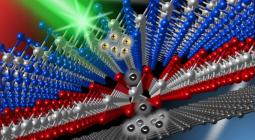Could Rust Be a New Source of Renewable Energy?

Using kinetic energy, it's got the potential to be more efficient than solar panels.
- A new study looks at how lab-made rust can could conduct electricity with salt water.
- Scientists claim that the technique could generate electricity at 30 percent efficiency, a higher rate than even modern solar panels.
- From buoys to scientific expeditions, this could help power objects already adrift in the ocean
Rust is often associated with decay and disrepair, but scientists at Caltech and Northwestern University are looking at rust differently: as a means of generating electricity.
Rust, after all, is nothing more than iron oxide. Thin films of it, as the scientists show in a new study, could be used to generate electricity when interacting with salt water. Combining metal compounds and salt water is a well-known way of conducting electricity, since chlorine and sodium ions can carry electrical currents. The process can even be replicated in your kitchen.
But the process at hand, developed by Caltech professor of chemistry Tom Miller and Dow Professor of Chemistry at Northwestern Franz Geiger, doesn't feature any chemical reactions. Instead, the team focused on Newton's 3rd Law—for every action, there is an equal and opposite reaction—by converting the kinetic energy of moving salt water into electricity.
This process is more commonly known as the electrokinetic effect and has been seen before in thin films of graphene, tightly bound in a carbon atom's honeycomb lattice. At its best, the electrokinetic effect can generate electricity with around 30 percent efficiency—that's noticeably higher than modern solar panels.
"FOR PERSPECTIVE, PLATES HAVING AN AREA OF 10 SQUARE METERS EACH WOULD GENERATE A FEW KILOWATTS PER HOUR—ENOUGH FOR A STANDARD U.S. HOME."
"A similar effect has been seen in some other materials. You can take a drop of saltwater and drag it across graphene and see some electricity generated," Miller says in a press statement.
The problem with graphene is scaling up. It could be expensive to get enough graphene to generate enough current to be useful. Rust, on the other hand, is very easy to acquire.
"It's basically just rust on iron, so it's pretty easy to make in large areas," Miller says. "This is a more robust implementation of the thing seen in graphene."
While rust could carry electricity, it's not the type of rust that grows on a disregarded boat. Naturally spreading rust is thick, too thick to be mass-produced, and doesn't spread evenly. The rust involved with this project would have to be developed with consistency in a lab. To achieve that, the scientists turned to a process called physical vapor deposition (PVD). During a PVD, a material begins in a condensed phase, transitions to a vapor phase, and then is moved back to a thin film condensed phase.
It's another well-known process, currently used to make thin film solar panels. Here, PVD allowed the team to create thin films of rust a mere 10 nanometers thick, thousands of times thinner than a human hair.
"The ions present in saltwater attract electrons in the iron beneath the layer of rust," the team explains in their press statement. "As the saltwater flows, so do those ions, and through that attractive force, they drag the electrons in the iron along with them, generating an electrical current." When flowed salt water over their rust-coated iron, the scientists found that it generated several tens of millivolts.
"For perspective, plates having an area of 10 square meters each would generate a few kilowatts per hour—enough for a standard U.S. home," Miller says. "Of course, less demanding applications, including low-power devices in remote locations, are more promising in the near term."
Perhaps the most obvious potential is for items that people already put in the ocean.
"Tidal energy, or things bobbing in the ocean, like buoys, could be used for passive electrical energy conversion," he says. "You have saltwater flowing in your veins in periodic pulses. That could be used to generate electricity for powering implants."
The vast majority of the planet's water is salt water, making it a ripe target for scientists looking to generate energy. Recently, a team at the King Abdullah University of Science and Technology in Saudi Arabia developed a method of using salt water to capture wasted heat from solar panels.
30 July 2019
POPULAR MECHANICS




